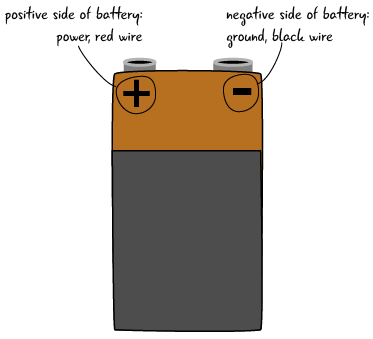Chapter 2: A note about power
Power for our circuit: electricity
The term power has a very specific meaning when talking about electricity, which we will explain later. For the moment, power here refers to the fact that electricity comes from our battery, passes through the resistor to the LED, and lights it up. Let’s take a closer look at how this is indicated both on our battery and with the color of the wires in our circuit. We looked at this briefly when attaching the battery cap, now we’ll look at it in more detail.
A word about power symbols
We’ve seen that there is a ‘+’, positive side and a ‘-’, or negative side on a battery, the conventional symbols used to mark which side of the battery produces power (positive) and which side is the ground (negative) side. (And we’ve seen the plus and minus sign on the busses on the breadboard.) We also saw that the positive side of the battery attached to the red lead on the battery cap and the negative side attached to the black lead on the battery cap.

Power
The ‘+’ sign, or the ‘positive’ marks the power side of your battery. The convention is that power flows from this side of the battery, and all paths in your circuit must trace back to the power side. Standards also state that all wires which are connected to the positive side are red. This way anyone who needs to look at or repair your circuit can immediately tell from where the power enters your circuit.
Ground
The ‘-’ is the negative side of the battery, also known as the ground side. Just as all paths in the circuit must begin with the power side, they must all end at the ground side if you trace them along the entire length. Ground can be thought of as the “zero” side, the place where all power has been used up. All wires that lead back to the ground part of the circuit should be black, as that will make it easier to work on your circuits and to know at a glance what parts are connected to ground.
We have looked a bit at power and ground, and we have built our circuit. But what if our LED didn’t light up? What steps can we take to find our problem and fix our circuit?
Questions?
Q: Do I need to use a new battery to light my LED? Can I use an old battery I found / borrowed from my living space?
A: Yes, you can, but chances are your lights won’t shine as bright as when you use a new battery. Batteries run out of power over time, which we will look at in a later chapter.